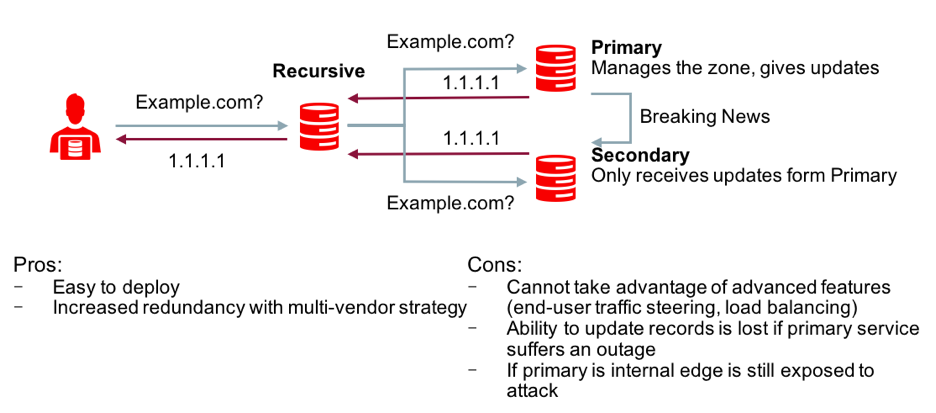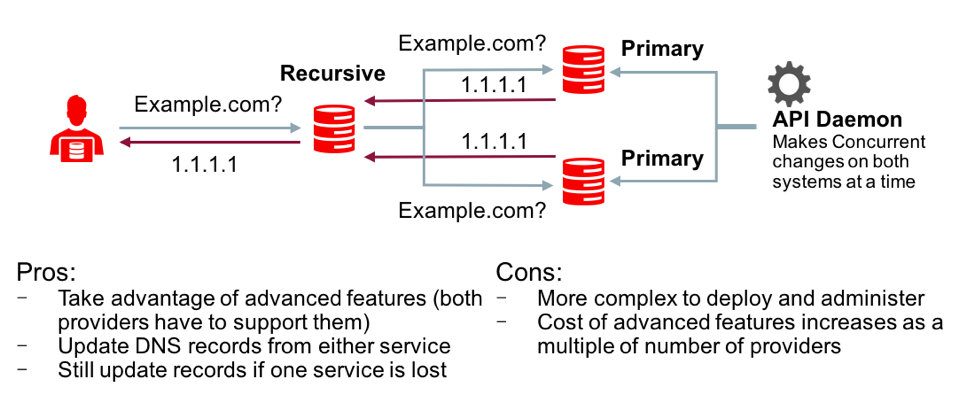In my last post, I looked at the importance of the edge for cloud-hosted resources from a user perspective. In this post I want to dig a little deeper and examine a couple strategies you should look for from a DNS service provider that is truly enterprise-ready. Combined, these strategies ensure high availability and an optimal user experience.
Anycast Addressing
Unlike unicast addressing for DNS, which can result in a user connecting to an arbitrary nameserver that may or may not be the optimal server and adds lag to the display of information, anycast broadcasts to all your DNS servers when they enter your URL, there is a better chance they will connect to the “best” DNS server resulting in a better user experience

The “best” server is determined by sending a request to all DNS servers and then directing traffic to the first DNS server that responds, resulting in choosing the DNS server with the lowest latency. If the “best” name server becomes unavailable anycast allows the user to connect to the “next best” DNS nameserver without having to wait for the request to time out. The result is a faster connection time. Oracle leverages Dyn’s anycast network to accelerate DNS resolution by automatically directing DNS queries to the “best” nameserver, ensuring lightning-fast DNS response around the world.
Multiple Tier-1 Providers at Each PoP
Having multiple tier-1 transit providers at each PoP enables a better user experience by offering redundancy and choice. A well-designed DNS architecture constantly monitors the performance of the transit providers and makes intelligent decisions as to the best way to forward traffic to the targeted site. This also builds in resiliency: when a transit provider becomes unavailable, others can handle the traffic. Oracle’s Managed DNS service connects directly to at least four tier-1 internet transit providers at each PoP to minimize latency and ensure high-availability.

Traffic Steering and Intelligent Routing
A modern cloud architecture requires intelligent, real-time traffic steering to avoid issues that affect the user experience. Load balancing and failover policies, combined with comprehensive internet performance visibility, help you achieve that goal. Key things to incorporate in your edge cloud strategy include:
- Active Failover: By continuously monitoring the health and status of endpoints, you can optimize the availability of your cloud-hosted applications and services.
- Geolocation Traffic Steering: Knowing where users and customers are coming form can significantly change how you route traffic. Traffic rules can vary by market and region, driven by latency, regionally specific products or languages, or to satisfy local regulatory requirements.
- Global Load Balancing: Dynamically configure how traffic is distributed across your infrastructure, assigning weighted value to each endpoint (cloud, CDN, data center, SaaS node).
- Multiple Endpoint Integration: Accelerate performance and maintain availability by steering traffic to alternative data stores if the original targeted data store is not available.
Dyn Managed DNS employs all these sophisticated DNS load balancing and routing techniques—analyzing over 240 billion data points a day to optimize DNS performance, accommodate traffic bursts, and ensure service continuity.
Redundant DNS Service
For redundancy and protection against user-affecting issues, many organizations are adopting a secondary DNS strategy. This means that if your primary DNS service suffers an outage or attack, the redundant service remains fully operational. Providers with a global DNS infrastructure enable you to easily implement a secondary, global DNS service and can often complement existing DNS service you may already have deployed. There are a few different methods to achieving DNS redundancy:
- Traditional primary-secondary option: The existing DNS solution acts as the primary DNS service from a records management perspective. Record updates are made in the primary service. The primary service automatically updates the secondary service and both services respond to DNS queries.

- Hidden master-secondary option: The existing DNS solution is deployed behind the corporate firewall and acts as the primary DNS services from a records perspective and then automatically updates the secondary service outside the corporate firewall. All traffic interacts with the secondary service.

- Primary-primary option: Each DNS service is updated independently. Records are synchronized across services manually with APIs or via an external application. Both services respond to DNS queries.

Oracle’s Managed DNS service can complement your existing DNS service or serve as the primary in all the methods described above.
Enterprise-Ready at the Edge
To be truly enterprise-ready, everything starts with the user. The users first interaction with your organization, portal, site or data is at the edge.
It is imperative that you understand not all DNS edge service providers deliver the same functionality and there are key strategies you need to look for to meet your goals in the new cloud-driven era. These strategies can be employed to deliver always-on availability and optimized performance that better connect your users to the resources they need.
To find out more about these strategies at the edge check out the Oracle Dyn website.
